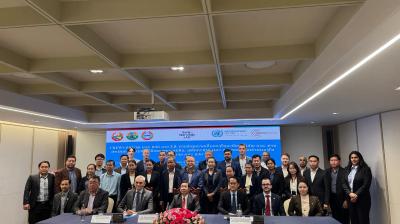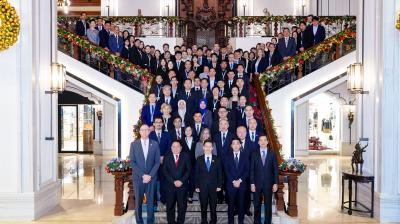Increasing water hazards demand better early warnings

Governments should “put your money where your mouth is” to ensure that the flagship UN Early Warnings for All initiative reaches its goal to protect everyone from dangerous weather by 2027, according to a top UN envoy.
“We can and must spare no effort to ensure that people and communities and countries are afforded with tools to save lives and livelihoods. We have a once in a generation opportunity to offer hope to those on the front line of the climate crisis. Let us not squander this opportunity,” Selwin Hart, Special Adviser to the Secretary-General on Climate Action and Just Transition, told a high-level side event at the UN 2023 Water Conference.
“It will be difficult but, with a miniscule investment this is achievable,” he said.
The Early Warnings for All initiative calls for initial new targeted investments between 2023 and 2027 of US$ 3.1 billion – a sum which would be dwarfed by the benefits. This is a small fraction (about 6 per cent) of the requested US$ 50 billion in adaptation financing.
UN Secretary-General chaired the first meeting of the initiative’s Advisory Panel on 21 March to begin implementation this year in at least 30 countries.
Water-related hazards like floods and drought as one of its main focuses of Early Warnings For All because they account for the majority of casualties and economic losses.
“The impacts of climate change are felt through water. We have seen an increase in flooding events and an increase in drought. In the UN framework, we are talking about loss and damage. One very powerful way to adapt to climate change and to avoid loss and damages is to invest in Early Warning Systems,” WMO Secretary-General Prof. Petteri Taalas told the side event.
Responding to the UN Secretary-General’s Call to Action: Realizing Early Warning Systems for All in a World with Increasing Water Related Hazards, was co-organized by WMO, the International Federation of Red Cross and Red Crescent Societies (IFRC) and the United Nations Office for Disaster Risk Reduction (UNDRR).
WMO, UNDRR, IFRC and the International Telecommunications Union are responsible for the four pillars of Early Warnings for All and used the side event to demonstrate how the meteorological, disaster risk reduction and humanitarian communities are joining forces with the communications and technology sectors.
“Risk is everybody’s business,” said Mami Mizutori, Special Representative of the Secretary-General for Disaster Risk Reduction and Head of UNDRR
The event was supported by the governments of Egypt, Tajikistan and the United States, with ministers or senior officials from these countries and from Japan and the Netherlands, voicing commitments to the initiative.
Early Warnings for All for water-related hazards is one of WMO’s commitments made at the UN 2023 Water Conference, which ends 24 March.

Four Pillars
- Disaster risk knowledge and management (US$374 million): aims to collect data and undertake risk assessments to increase knowledge on hazards and vulnerabilities and trends. Led by UNDRR with support from WMO.
Countries need help to develop guiding strategies across all four phases of multi-hazard early warning systems and to mobilise resources, technology and capacity to implement the strategies. Vulnerability data should be integrated into early warning systems, including information on human health, ecosystem health and gender. Where possible, early warning systems should be linked to social protection systems, said Ms Mizutori.
- Detection, observations, monitoring, analysis and forecasting of hazards (US$1.18 billion). Develop hazard monitoring and early warning services. Led by WMO, with support from UN Development Programme (UNDP), UN Educational, Scientific and Cultural Organization (UNESCO) and UN Environment Programme (UNEP).
Currently only half WMO Members have early warning systems in place and there are big gaps in the global basic observing system. WMO is seeking to scale up the Climate Risk Early Warning Systems (CREWS) Initiative and the Systematic Observations Financing Facility (SOFF). “Our desire is by end of 2027, we will have 100 percent coverage with Early Warning Systems,” said Prof. Taalas. Better monitoring and prediction of floods and droughts is part of this pillar, which seeks to strengthening the capacity of National Meteorological and Hydrological Services.
- Dissemination and communication (US$ 550 million). Communicate risk information so it reaches all those who need it, and is understandable and usable. Led by ITU, with support from IFRC, UNDP, and WMO.
A multi-channel approach sending alerts over radio, television, mobile networks, social media, sirens increases the effectiveness of an alert and helps address the diversity of communities at risk. The Common Alerting Protocol (CAP), a standardized data format to exchange public warnings.
In 2022, 95 percent of the world’s population had access to mobile broadband networks and close to 75 percent of the population owned a mobile phone, making mobile networks powerful communication channels which can target those located in an at-risk area. But very few developing, countries have put these relatively low-cost systems in place. This must change,
“We hope to leverage ITU’s unique membership of public and private sector members, including the mobile and satellite industry, to build on existing, and look into innovative, solutions to bridge the last mile, reduce costs, and address and overcome gaps to ensure that no one is left behind. This includes looking into the opportunities of Artificial Intelligence to scale the dissemination of actionable alerts, “ said Ursula Wynhoven, Head of the ITU New York Office.
- Preparedness and response ($1 billion) : Build national and community response capabilities.Led by IFRC, with support from Risk Informed Early Action Partnership (REAP), Office for the Coordination of Humanitarian Affairs (OCHA), Food and Agriculture Organization (FAO), and World Food Programme (WFP).
IFRC Secretary-General Jagan Chapagain cited the example of Tropical Cyclone Freddy, which killed more than 200 people in Malawi and Mozambique in March 2023, destroying or damaging homes and infrastructure. Ahead of the storm, the Malawi Red Cross supported the government in issuing warnings via the radio and loudspeaker vehicles. It activated early and anticipatory actions, by prepositioning stocks of temporary shelters, food, and hygiene and sanitation items, and supporting people, including through cash assistance, to evacuate hazard areas and move to higher ground.
“Although the impacts from Cyclone Freddy were terrible, it was predicated. Yet, without early warnings and actions – the devastation could have been unimaginable,” he said.
It is vital to ensure that the early warning and early action plans and systems are people-centred and place communities in the driver’s seat of planning and implementation. This includes forecasting and alerting that considers community risks, delivered across trusted channels with targeted, actionable guidance; while ensuring that communities are organized, trained and equipped to act before and after a disaster.
“We will strive to ensure that early warning systems are accompanied by local and national response capabilities, where early warnings lead to early action, » said Mr Chapagain.










